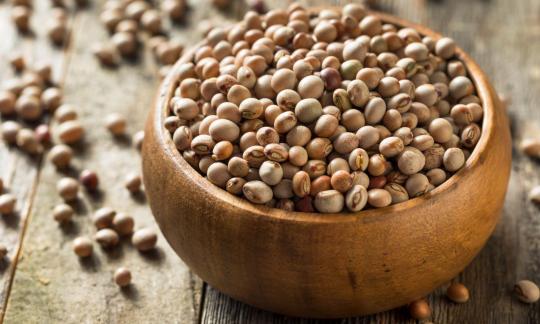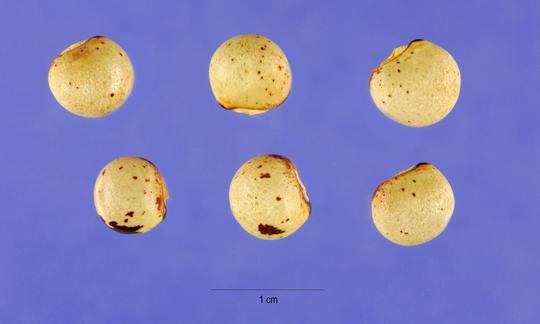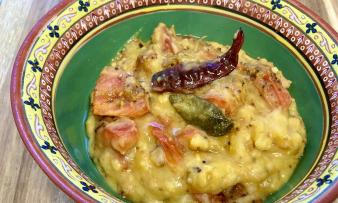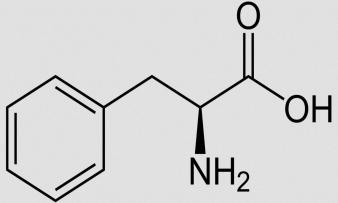Table of contents
Ripe seeds of the pigeon pea ( Cajanus cajan), also known as pigeon pea, have a strong nutty taste. They are used in a similar way to lentils, never raw and mainly in Indian, Caribbean and African cuisine. Whenever possible, look for organic quality.
Use in the kitchen
Ripe pigeon peas have a dark, earthy brown color and a strong, nutty flavor. This is somewhat more intense than the green , unripe pigeon pea. Pigeon peas are actually beans, although they are called peas because of their size. The ripe variety is dried, which is why they are usually used in recipes that require longer cooking times. In stews or soups, they are given enough time to develop a soft texture and fully develop their flavor. You can basically replace the dried bean with any other dried pea, bean or lentil.
Regardless of whether you use fresh or dried pigeon peas, you should cook them before using them and, like other pulses, never eat them raw. Ripe pigeon peas go well in soups, stews, curries, sauces, salads and rice dishes. Their taste goes well with mango, coconut, onion, tomato, ginger, lemon juice, turmeric, coriander, cumin, curry powder, coconut milk and rice. A famous pigeon pea recipe from India is dal (dahl). In addition to their use in Indian cuisine, they are a popular ingredient in West African and Caribbean soups, stews and rice dishes. You can also grind ripe, dried pigeon peas into gluten-free flour. Pigeon pea flour is used to make bread, biscuits and chapatis (flatbreads) because it is high in protein, iron and phosphorus. It is therefore recommended in school feeding programs and for vulnerable populations in developing countries. 1
Dishes with bean sprouts from pigeon peas ("Taoge") are well-known and popular in India. 22
Homemade preparation
Dried pigeon peas should be soaked for a few hours or overnight before cooking so that they are easier to digest (see Dangers, Intolerances, Side Effects). Cooking also inactivates the heat-sensitive trypsin inhibitors they contain, which can cause digestive problems in humans. 1,2
Vegan recipe for vegetable stew with pigeon peas
Ingredients (for 6 people): 1 tbsp rapeseed oil (refined), 450 g dried pigeon peas (organic), 1 onion, 4 cloves of garlic, 2 carrots (medium), 1 pumpkin (small), 1 white cabbage (small), 400 g chopped tomatoes, 1 tsp salt, 1 tsppepper, ½ tsp curry powder, 3 sprigs of fresh thyme, 250 ml vegetable stock, 250 ml coconut milk (or oat cream).
Preparation: Bring the pigeon peas to the boil in a large pot of water, then remove from the heat and let the beans soak for an hour. Alternatively, you can soak them overnight by placing them in a pot of cold water and making sure that they are well covered by the water. Heat the rapeseed oil in a large saucepan. Peel and chop the onions, garlic and carrots, then sauté for a few minutes. Gradually add the spices (salt, pepper and curry) to taste. Cut the cabbage, peel the pumpkin and also cut it into bite-sized pieces, add it and cook for three to four minutes. Add the liquid ingredients - coconut milk and vegetable stock as well as the pigeon peas and chopped tomatoes - and mix everything well. Bring to the boil and simmer covered for about 2 hours. Then serve the vegan vegetable stew with pigeon peas in plates and enjoy.
Vegan recipes with ripe pigeon peas can be found under the note: " Recipes that have the most of this ingredient ".
| Not only vegans or vegetarians should read this: Vegans often eat unhealthily. Avoidable nutritional errors. |
Purchasing - Storage
Where can you buy pigeon peas? The best way to get pigeon peas (dried seeds) is online, in Asian shops or Indian delicatessens. They are often only available peeled and halved, as Dal (Toor Dal Dhuli). Major retailers such as Coop, Migros, Denner, Volg, Spar, Aldi, Lidl, Rewe, Edeka, Hofer, Billa or organic supermarkets such as Denn's Biomarkt and Alnatura do not stock fresh or dried pigeon peas as standard. Buying organic pigeon peas can sometimes be difficult.
The harvest months ( season) in the growing areas are December and March. 21
The availability of ripe pigeon peas varies depending on the size of the store, catchment area, etc. Our recorded food prices for the DA-CH countries can be found above under the ingredient image - and by clicking on them you can see their development at various suppliers.
Storage tips
Ripe pigeon peas should be stored in a cool, dark place in an airtight container, similar to lentils. They will generally last for 2 years there. 3
Ingredients - Nutritional values - Calories
100 g of ripe pigeon peas provide 343 kcal. These consist of 1.5 g fat, 63 g carbohydrates and 22 g protein. 4 The ingredients can change or decrease during the cooking process.
The folate content (ex Vit. B9, B11) is 456 µg/100g. This covers 228% of the daily requirement. Lentils (479 µg/100g) and black beans (444 µg/100g) have similar values. Mung beans (625 µg/100g) contain particularly high amounts. 4 The water-soluble vitamin is reduced by cooking.
Manganese is present at 1.8 mg/100g (90% of the daily requirement). Red lentils (1.7 mg/100g) and white beans (1.8 mg/100g) have the same or similar amounts. Goa beans contain more than twice as much manganese (3.7 mg/100g). 4
100 g of ripe pigeon peas contain 1392 mg of potassium. This covers 70% of the daily requirement. Kidney beans (1406 mg/100g) and borlotti beans (1332 mg/100g) contain similar amounts. White beans contain 1795 mg/100g. 4
Pigeon peas also contain valuable secondary plant substances such as alkaloids, flavonoids, sterols and phenols. 5
The complete ingredients of ripe pigeon peas, the coverage of the daily requirement and comparison values with other ingredients can be found in our nutrient tables. In the article Nutrients explained you will get a detailed insight into the topic.
Health effects
Cajanus cajan is a good source of carbohydrates, proteins, fats and minerals, and makes an important local contribution to human and animal nutrition. Eating pigeon peas has several health benefits due to the presence of bioactive compounds. They can help control weight, help relieve cholesterolemia and diabetes, and are therefore also a remedy for metabolic syndrome (the appearance of various symptoms such as obesity, high blood pressure and disorders of sugar and lipid metabolism). 6 Carbohydrates, proteins, minerals, essential amino acids and vitamins are present in both the ripe (dried) and immature seeds. 2 A study of the seeds, leaves and roots of C. cajan concluded that the seeds have the best nutritional properties due to the presence of protein, ash and minerals (calcium, magnesium and iron). In addition, they contain a relatively high content of essential amino acids and BCAAs ( branched - chain amino acids leucine, valine and isoleucine), which are even higher than in soybeans. BCAAs serve as building materials and fuel for muscle cells. In contrast , the antioxidant activity of the roots of C. cajan is better than that of the seeds and leaves. 7
Secondary plant substances
Many of the health effects of unripe pigeon peas can be attributed to the secondary plant substances they contain. Our article on secondary plant substances provides an overview of the classification of substance groups, their occurrence in foods and possible effects on humans.
In addition to the roots 7, the seeds also contain certain amounts of antioxidant substances that can help alleviate and prevent health problems associated with oxidative stress, such as cancer and cardiovascular disease. 8 The seeds, leaves and roots of C. cajan contain significant amounts of saponins (secondary plant compounds) that are important for reducing high blood cholesterol levels. Studies on cooked seeds have also shown a significant reduction in blood sugar levels. 2
C. cajan is best known for its use in folk medicine to treat various ailments such as toothache, dizziness, diabetes, stomach pain, gynecological disorders and chronic infections. These properties are attributed to the presence of several valuable nutrients and bioactive components. 9
Dangers - Intolerances - Side effects
As with other pulses, raw pigeon pea seeds contain protein inhibitors (typsin and chymotrypsin) and amylase inhibitors, which impair the activity of digestive enzymes and can therefore cause digestive losses. Oligosaccharides such as stachyose, raffinose and verbascose are also contained in raw pigeon peas and can cause flatulence. These substances should be inactivated before consumption, e.g. by soaking, sprouting or cooking. Soaking reduces nutrient-defying substances, particularly oligosaccharides and members of the raffinose family. 1 Phytic acid, which insoluble binds minerals absorbed in the human stomach and intestines such as calcium, magnesium, iron and zinc, 10 can also be reduced by soaking. A longer soaking time also means a greater reduction in phytic acid. Read more about this in our article Phytic acid or phytate and soaking or sprouting.
Some people react allergically or with intolerances to the consumption of pulses such as pigeon peas. 11 The spectrum of allergies is individual and can change over time. Pulses are cross-reactive with grass pollen. An existing allergy to pollen from grass or grains can thus cause sensitization to pulses. 12 A distinction must be made between real allergies and intolerance reactions (intolerances). Real allergies often occur immediately after eating the food and are manifested by severe itching in the mouth or a burning sensation in the throat. Food intolerances, on the other hand, manifest themselves during digestion, e.g. through flatulence or cramps.
Folk medicine - naturopathy
Folk medicine in some areas of India, Bangladesh, China and other countries uses the leaves, seeds, stems and roots of C. cajan to treat various ailments such as toothache, diabetes, dizziness, baldness and gastrointestinal complaints. In Oman, the seeds are used to treat chronic infections and the juice of the leaves is used to relieve various dermatological diseases. The flower decoction was used in ancient times to treat pneumonia, coughs, menstrual cramps, dysentery and bronchitis, while the leaf decoction was used in eastern Nigeria to treat measles. 9
Ecological footprint - animal welfare
The ecological footprint of a food depends on various factors. The type of agricultural production (conventional vs. organic), seasonal, regional or domestic production or import by truck, ship or plane, different types of packaging and whether the goods are fresh or frozen all play a decisive role. 13
Despite intensive research, we were unable to find any information on the carbon footprint of dried pigeon peas (green, unripe pigeon peas are calculated at 0.92 kg CO 2 eq/kg). 14 In comparison, green and red lentils are given a carbon footprint of 2.46 kg CO 2 eq/kg. 15 If grape peas are exported, an additional burden from transport emissions can be expected.
The amount of water required to produce 1 kg of pigeon peas is 5494 litres. It is not clear from the study whether this water footprint refers to dried or fresh specimens. 16
For detailed explanations of various sustainability indicators (such as ecological footprint, CO2 footprint, water footprint), see our article: What does the ecological footprint mean?
In addition to being used as a main crop, pigeon peas are also known for intercropping or as green manure. As legumes, they can fix atmospheric nitrogen and make it available for the subsequent crop. They are popular with main crops such as millet, sorghum, corn or cowpeas. 19
Worldwide occurrence - cultivation
Probably originating from India, pigeon peas have been cultivated for at least 3700 years. The earliest archaeological evidence comes from the southern peninsula and eastern India. It spread to Thailand around 2000 years ago. 17 Today it grows in much of Asia, Africa, Central America and northern South America, 18 where it feels at home in tropical and subtropical climates and has proven itself to be a fast-growing and adaptable legume. 2 In 2022, India was by far the largest producer of dried pigeon peas. 19
Cultivation - Harvest You can also grow
Cajanus cajan in your own garden under certain conditions. It is a short-lived, perennial plant that usually lasts 4 to 5 years. Its most productive harvest occurs in its first year. It takes about 120 to 200 days to fully ripen. Pigeon peas can grow up to 3.5 m tall. 3 Pigeon peas grow in a variety of soil types, from sandy to heavy clay soils, including those with low fertility. They thrive best in soils with a pH of 5 to 7, but can also tolerate a wider range (4.5-8.4). Like most pulses, they do not do well with waterlogging or flooding over a long period of time. The plant is, however, very heat tolerant and thrives in hot, humid climates; with annual rainfall between 600 and 1000 mm. It is generally grown at temperatures between 18 °C and 30 °C, but can tolerate temperatures of 35 °C or more in moist soil conditions. 20
After the danger of frost has passed and spring temperatures have warmed, sow the seeds one inch deep, spaced 3 to 4 inches apart. It is best to till the soil a few inches deep before sowing. Water the plant well and keep the soil moist until the seedlings emerge, which may take a couple of weeks. The first few weeks after seed germination are important. Make sure the soil is moist but not wet and the area is free of weeds. Cajanus cajan usually does well without additional fertilizer and takes up to a month to establish. Once they are about 5 inches tall, growth picks up speed and can reach up to 5 inches per week. At this point, you can scale back on care a little. 3
If you want to harvest mature seeds, let the pods dry on the plant until they are brownish. Either pull the whole plant out and remove the pods, or cut the pods off if you are growing the plants as perennial shrubs. Separate the seeds from the dry pods with your hands, working on a table covered with a cloth or newspaper. Then let them dry for a few days in a cool, dark place. Place them on a surface with good air circulation where they will not stick, e.g. on a brown paper bag. When they are completely dry, store them in an airtight container (see storage tips). If you have space, place the seeds you want to sow next season in a refrigerator at a temperature of 0 to 5 °C. If this is not possible, try to find another cool, dry room, e.g. an unheated garage or the pantry in the kitchen. 3
Further information
Pigeon peas ( Cajanus cajan) belong to the legume family (Fabaceae). The color indicates the ripeness of the bean. If it is green, it was harvested at an earlier stage. Brown pigeon peas, on the other hand, ripen and dry on the plant before harvesting.
Alternative names
In German, the terms "pea bean" or "pigeon pea" are used as synonyms. In English, they are called "pigeon peas", "red gram", "Angola pea" or "Congo pea". In Spanish, they are known as "Gandules (verdes)", "Guandules", "Guandúl", "frejol de palo" or "Quinchoncho" and in India as "Arhar" and "Toor Dal".
Latin synonyms are: Cajanus indicus Spreng., Cajanus fllavus DC. and Cytisus cajan L. 17
Other uses
Pigeon pea is not only a valuable source of food, the leaves are also used as animal feed and the woody parts of the plant as firewood. The woody stems are also used as roof straw and for temporary fences. 20
The shellac used in the past comes from scale insects ( Laccifer lacca), which live on Cajanus plants, among others. In Madagascar, pigeon pea leaves are used as food for silkworms. 22
Bibliography - 22 Sources
| 1. | Sharma S, Agarwal N, Verma P. Pigeon pea (Cajanus cajan L.): A Hidden Treasure of Regime Nutrition. Journal of Functional and Environmental Botany. 2011;1(2):91–101. |
| 2. | Kuraz Abebe B. The Dietary Use of Pigeon Pea for Human and Animal Diets. The Scientific World Journal. 2022;2022:1–12. |
| 3. | Gardeners Path com: How to Plant and Grow Pigeon Peas. 2022. |
| 4. | USDA United States Department of Agriculture. |
| 5. | Gerrano AS, Moalafi A, Seepe HA, Amoo S, Shimelis H. Nutritional and phytochemical compositions and their interrelationship in succulent pods of pigeonpea (Cajanus cajan [L.] Millsp.). Heliyon. 2022;8(3):e09078. |
| 6. | Talari A, Shakappa D. Role of pigeon pea (Cajanus cajan L.) in human nutrition and health: A review. Asian Journal of Diary and Food Research. 2018;37(3):212–220. |
| 7. | Yang SE, Vo TLT et al. Nutritional Composition, Bioactive Compounds and Functional Evaluation of Various Parts of Cajanus Cajan (L.) Millsp. Agriculture. 2020;10(11):558. |
| 8. | Tekale SS, Jaiwal BV, Padul MV. Identification of metabolites from an active fraction of Cajanus cajan seeds by high resolution mass spectrometry. Food Chemistry. 2016;211:763–769. |
| 9. | Gargi B, Semwal P et al. Revisiting the Nutritional, Chemical and Biological Potential of Cajanus cajan (L.) Millsp. Molecules. 2022;27(20):6877. |
| 10. | Chemie de: Phytinsäure. |
| 11. | Aha! Allergiezentrum Schweiz. Erbsen sind im Trend – aber auch allergen. 2021. |
| 12. | DEBInet Deutsches Ernährungsberatungs- & Informationsnetz. Nahrungsmittelallergien - Pollen. |
| 13. | Reinhardt G, Gärtner S, Wagner T. Ökologische Fussabdrücke von Lebensmitteln und Gerichten in Deutschland. IFEU Institut für Energie- und Umweltforschung Heidelberg ifeu. 2020:1-22. |
| 14. | Carboncloud com: Green Pigeon Peas. |
| 15. | Concito. Denmark's green think tank. The big Climate Database. Version 1. Green lentils, dried, Red lentils, dried. |
| 16. | Mekonnen MM, Hoekstra AY. The green, blue and grey water footprint of crops and derived crop products. Hydrol. Earth Syst. Sci. 2011;15:1577–1600. |
| 17. | Fuller DQ, Murphy C et al. Cajanus cajan (L.) Millsp. origins and domestication: the South and Southeast Asian archaeobotanical evidence. Genet Resour Crop Evol. 2019;66(6):1175–1188. |
| 18. | Royal Botanic Gardens Kew. Cajanus cajan (L.) Huth. |
| 19. | FAO Food and Agriculture Organization of the United Nations. Crops and livestock products. Pigeon peas, dry. Production Quantity 2022. |
| 20. | Universität of Hawai Manoa. Valenzuela H, Smith J. Pigeonpea. Sustainable Agriculture Green Manure Crops. 2002:1–3. |
| 21. | Venkataratnam N, Sheldrake AR. Second harvest yields of medium duration pigeonpeas (Cajanus cajan) in peninsular India. Field Crops Research. Januar 1985;10:323–32. |
| 22. | Uni-Giessen. Leguminosen zur Kornnutzung. Straucherbse (Cajanus cajan [L.] Millsp. [= C. indicus Spreng.]) 2015. |











Comments